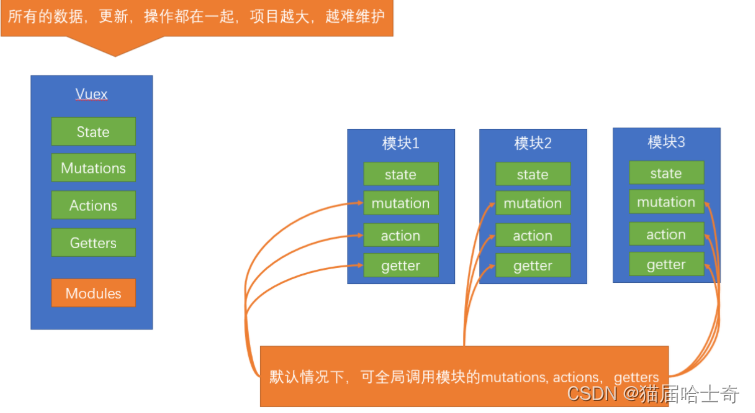核心概念- state状态
State提供唯一的公共数据源,所有共享的数据都要统一放到Store中的State中存储。
打开项目中的store.js文件,在state对象中可以添加我们要共享的数据。
// 创建仓库 store
const store = new Vuex.Store({
// state 状态, 即数据, 类似于vue组件中的data,
// 区别在于 data 是组件自己的数据, 而 state 中的数据整个vue项目的组件都能访问到
state: {
count: 101
}
})问题: 如何在组件中获取count?
-
插值表达式 =》 {{ $store.state.count }}
-
mapState 映射计算属性 =》 {{ count }}
1 原始形式 - 通过仓库直接访问
App.vue
组件中可以使用 this.$store 获取到vuex中的store对象实例,可通过state属性属性获取count, 如下
<h1>state的数据 - {{ $store.state.count }}</h1>
计算属性 - 将state属性定义在计算属性中 State | Vuex
// 把state中数据,定义在组件内的计算属性中
computed: {
count () {
return this.$store.state.count
}
}
<h1>state的数据 - {{ count }}</h1>
但是每次, 都这样一个个的提供计算属性, 太麻烦了, 所以我们需要辅助函数 mapState 帮我们简化语法
2 辅助函数 - mapState
mapState是辅助函数,帮助我们把store中的数据映射到 组件的计算属性中, 它属于一种方便的用法
用法 :
第一步:导入mapState (mapState是vuex中的一个函数)
import { mapState } from 'vuex'
第二步:采用数组形式引入state属性
mapState(['count'])
上面代码的最终得到的是 类似于
count () {
return this.$store.state.count
}
第三步:利用展开运算符将导出的状态映射给计算属性
computed: {
...mapState(['count'])
}
<div> state的数据:{{ count }}</div>
核心概念 - mutations
基本使用
通过 strict: true 可以开启严格模式
state数据的修改只能通过mutations,并且mutations必须是同步的
定义mutations
const store = new Vuex.Store({
state: {
count: 0
},
// 定义mutations
mutations: {
}
})
格式说明
mutations是一个对象,对象中存放修改state的方法
mutations: {
// 方法里参数 第一个参数是当前store的state属性
// payload 载荷 运输参数 调用mutaiions的时候 可以传递参数 传递载荷
addCount (state) {
state.count += 1
}
},
组件中提交 mutations
this.$store.commit('addCount')
解决问题: 两个子组件, 添加操作 add, addN 实现
带参数的 mutation
提交 mutation 是可以传递参数的 this.$store.commit('xxx', 参数)
1 提供mutation函数
mutations: {
...
addCount (state, count) {
state.count = count
}
},
2 提交mutation
handle ( ) {
this.$store.commit('addCount', 10)
}
小tips: 提交的参数只能是一个, 如果有多个参数要传, 可以传递一个对象
this.$store.commit('addCount', {
count: 10
})
辅助函数 - mapMutations
mapMutations和mapState很像,它把位于mutations中的方法提取了出来,我们可以将它导入
import { mapMutations } from 'vuex'
methods: {
...mapMutations(['addCount'])
}
上面代码的含义是将mutations的方法导入了methods中,等价于
methods: {
// commit(方法名, 载荷参数)
addCount () {
this.$store.commit('addCount')
}
}
此时,就可以直接通过this.addCount调用了
<button @click="addCount">值+1</button>
但是请注意: Vuex中mutations中要求不能写异步代码,如果有异步的ajax请求,应该放置在actions中
核心概念 - actions
state是存放数据的,mutations是同步更新数据 (便于监测数据的变化, 更新视图等, 方便于调试工具查看变化),
actions则负责进行异步操作
需求: 一秒钟之后, 要给一个数 去修改state

定义actions
actions: {
setAsyncCount (context, num) {
// 一秒后, 给一个数, 去修改 num
setTimeout(() => {
context.commit('changeCount', num)
}, 1000)
}
},
原始调用 - $store (支持传参)
setAsyncCount () {
this.$store.dispatch('setAsyncCount', 666)
}
辅助函数 -mapActions
actions也有辅助函数,可以将action导入到组件中
import { mapActions } from 'vuex'
methods: {
...mapActions(['setAsyncCount'])
}
直接通过 this.方法 就可以调用
<button @click="setAsyncCount(200)">+异步</button>
核心概念 - getters
除了state之外,有时我们还需要从state中派生出一些状态,这些状态是依赖state的,此时会用到getters
例如,state中定义了list,为1-10的数组,
state: {
list: [1, 2, 3, 4, 5, 6, 7, 8, 9, 10]
}
组件中,需要显示所有大于5的数据,正常的方式,是需要list在组件中进行再一步的处理,但是getters可以帮助我们实现它
定义getters
getters: {
// getters函数的第一个参数是 state
// 必须要有返回值
filterList: state => state.list.filter(item => item > 5)
}
使用getters
原始方式 -$store
<div>{{ $store.getters.filterList }}</div>
辅助函数 - mapGetters
computed: {
...mapGetters(['filterList'])
}
<div>{{ filterList }}</div>
命名空间 namespaced

默认情况下,模块内部的 action、mutation 和 getter 是注册在全局命名空间的
这句话的意思是 刚才的 user模块 还是 setting模块,它的 action、mutation 和 getter 其实并没有区分,都可以直接通过全局的方式调用, 如下图所示:
但是,如果我们想保证内部模块的高封闭性,我们可以采用namespaced来进行设置
modules/user.js
const state = {
userInfo: {
name: 'zs',
age: 18
},
myMsg: '我的数据'
}
const mutations = {
updateMsg (state, msg) {
state.myMsg = msg
}
}
const actions = {}
const getters = {}
export default {
namespaced: true,
state,
mutations,
actions,
getters
}
提交模块中的mutation
全局的: this.$store.commit('mutation函数名', 参数)
模块中的: this.$store.commit('模块名/mutation函数名', 参数)
namespaced: true 后, 要添加映射, 可以加上模块名, 找对应模块的 state/mutations/actions/getters
computed: {
// 全局的
...mapState(['count']),
// 模块中的
...mapState('user', ['myMsg']),
},
methods: {
// 全局的
...mapMutations(['addCount'])
// 模块中的
...mapMutations('user', ['updateMsg'])
}







 本文详细介绍了Vuex中的核心概念,包括state、mutations、actions和getters的使用。通过实例展示了如何在组件中获取和修改state,如何使用mapState、mapMutations简化代码,以及如何处理异步操作和创建计算属性。同时,还讨论了命名空间namespaced的配置和使用。
本文详细介绍了Vuex中的核心概念,包括state、mutations、actions和getters的使用。通过实例展示了如何在组件中获取和修改state,如何使用mapState、mapMutations简化代码,以及如何处理异步操作和创建计算属性。同时,还讨论了命名空间namespaced的配置和使用。
















 2855
2855

 被折叠的 条评论
为什么被折叠?
被折叠的 条评论
为什么被折叠?








